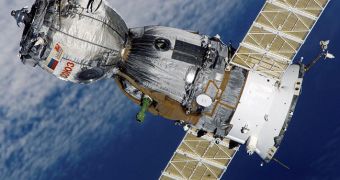The three astronauts aboard the International Space Station (ISS) took shelter on Thursday in their Soyuz spacecraft, which was instantly turned into a lifeboat of sorts. The move was prompted by a Flight Control warning, which was issued on account of a tiny piece of space debris. The satellite motor remnant passed very close to the ISS, at an estimated distance of 2.4 miles (4 kilometers), but it traveled at a mind-boggling 19,800 mph, which meant that, even though it was only a third of an inch long, it could have drilled a hole in the outer hull of the station.
Space debris found in the Earth orbit may seem harmless to some, given that most of them only have very small dimensions. What these people forget is the fact that these objects are accelerated to enormous speeds. While moving at more than 10 or 15,000 mph, they can easily pass through the equivalent of a concrete wall, which means that the relatively thin walls of the ISS modules are in no way suited to stop them. And these fragments get more dangerous as their size increases.
The Mission Control ordered the two Americans and the one Russian aboard the station to leave their labs and move into the Soyuz module, in case the tiny piece of space junk would penetrate the outer hulls of the station and cause it to lose pressure. Although the crew didn't completely close the hatch between the Soyuz and the rest of the ISS, NASA spokesperson Brandi Dean told Space that the three astronauts had been prepared to do so at any point.
“The closure of the hatches ensures the safety of the crew and the ability to quickly depart the station in the unlikely event the debris collided with the station causing a depressurization. Moving the crew into the Soyuz is a precaution, as the probability of impact is low,” officials from NASA stated. “Sandy (flight engineer Sandra Magnus) kept her eyes out the Soyuz windows and we didn't see anything, of course. But we were wondering how close things were. We'd be interested in that,” US mission commander Michael Fincke transmitted from the ISS.
This is the second time the crew aboard the orbital facility has to move to the Soyuz module, with the first time being on November 17th, 2008, when remains from a rocket flew some 12 miles (19 kilometers) away from the ISS and the astronauts were asked to take shelter in the “lifeboat.” Now, the situation is even more complicated for the Discovery space shuttle, as the recent collision between an American and a Russian satellite over Siberia has spilled numerous pieces of debris in orbit, upping the chances for the shuttle being hit by one some 6 percent.

 14 DAY TRIAL //
14 DAY TRIAL //